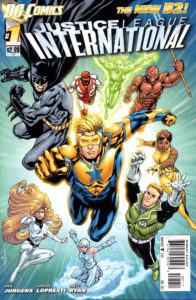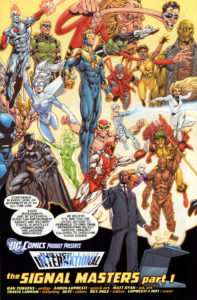On Saturday I realized I had been actively avoiding Justice League International.
As a fair representation as a lifelong DC skimmer, I look at this cover and see Batman, a lame alternate version of Green Lantern, and a bunch of unidentifiable nobodies. Not exactly the most-inspiring reason to read a comic book.
That’s always been one of my major problems with DC – past the heavy-hitters from Justice League of America and a handful of other heroes we all played with in the 80s as super-friends toys, I’ve never heard of these people. Unlike Marvel, they don’t sprout from one of just a handful of classic lines of 60s and 70s titles. I suppose you could say the same thing for the extended supporting cast of the Avengers or the X-Men, but they’re part of a larger interconnected family of stories. Even when they’re off panel their lives are being affected by what’s happening.
Can you say the same for Godiva or Vixen?
I seriously don’t know! Maybe I’m just projecting my DC distaste – but this weekend I finally sat down to find out by reading this issue.

Justice League International #1
Written by Dan Jurgens, art by Aaron Lopresti & Matt Ryan
Rating: 2.5 out of 5 – Okay.
In a line: “A different Justice League?”
140char Review: Justice League Int’l #1 is a standard “let’s start a team” take on a redebut, cribbing Giant Size X-Men. Plot set motion, but not thrilling.
Plot & Script
Dan Jurgens is a comics veteran – he knows how to structure a first issue and introduce a new team.
He starts with an effective and not-unappreciated device of performing a roll-call of potential members that reveals their countries of origin, though a quick primer on powers may have also been warranted. A UN security guy informs his committee “No masks or hidden identities” … and then tries to pick Batman? The committee members were wise to decline, yet Bats is still on flying the jet when the mission takes off. Doesn’t that make him a hijacker? I think it’s the League’s duty to restrain him.
Everyone gets at least three on-panel moments – their roll call intro, lines within the Hall of Justice, and on the battle field. We also get to see each member in action at least once. As a result, a newer reader has some way of identifying (and identifying with) a team of relative strangers.
The whole scene outside of the Hall of Justice doesn’t especially make sense. We’ve been lead to believe this is a world that hates and fears heroes – or, at least, it did five years ago when Justice League and Action Comics are set. Why, then, are there protesters outside of a Hall of Justice? Who would there be to assemble inside said hall? And, why had they vacated to allow the UN inside? Furthermore, we see that all these heroes seem to know each other and their work, which is also confusing in the context of this week’s books.
Weirdly, the only person who gets any character depth is Guy Gardner, who promptly disappears (I assume he is an act one gun that will come back in the third to save the day.) I was especially confused by the bullish Guy Gardner as a Green Lantern, since we see a different Green Lantern in Justice League. I thought there was only one per sector?
 I suppose all will be answered, but the issue felt weirdly out of place against all of the other books this week. Also, this seriously plagiarizes Giant Size X-Men in a number of different ways, right down to the geological horror of the villain.
I suppose all will be answered, but the issue felt weirdly out of place against all of the other books this week. Also, this seriously plagiarizes Giant Size X-Men in a number of different ways, right down to the geological horror of the villain.
Artwork
Lopresti ads to the slightly retro feel of the book with a charming, ultra-heroic take on the characters. It’s not super-exciting, but it’s solid pencil work that nicely complements Jurgens’ story. I especially love his faces, which are distinct and expressive throughout, helping to sell a mostly “talking heads” issue.
In the past I’ve found Lopresti to be a bit rigid and stodgy, but that’s not the case here – maybe due to inker Ryan, or maybe from the beautifully understated set of colors. Characters feel as though they have weight, but also momentum. Godiva is especially lovely, Booster is a definitive over-muscled hero, and Batman has a lurking quality with his tendril-like cape. The action is limited to just a few pages at the end, but what we see is effective.
(In the final fight Vixen gets a Phoenix-esque flame effect around her body as she flies off the ground. I was confused as to whether Fire was using harmless flames to lift Vixen into the air or if this was a power beyond the seemingly Black Panther set of agility and claws.)
CK Says: Consider it.
Justice League International has a slight by-the-numbers feel thanks to its hastily assembled multicultural team of heroes (plus hanger-on Batman) responding to orders from a bald guy to face an unspecified geological terror. It’s Comics 101 – and, effectively the first half of Giant-Size X-Men #1.
Jurgens works to quickly establish the personalities and conflicts of all the members within the somewhat rote, old-school story. No Morrison-style existential dilemmas here. We’re given at least a hint of the attitudes of each and their powers were all obvious enough to be telegraphed by the art in a few panels of battle (except for Booster’s, which are unclear).
The bottom line is that this cookie-cutter approach aims the book more towards the DC insider than the newbie. A long-time DC fan will likely be excited to read the B-list characters they’ve grown to love (as I would be on an X-Men b-team). It’s a good intro for a new reader, but I’m not sure it’s worth revisiting in another month.